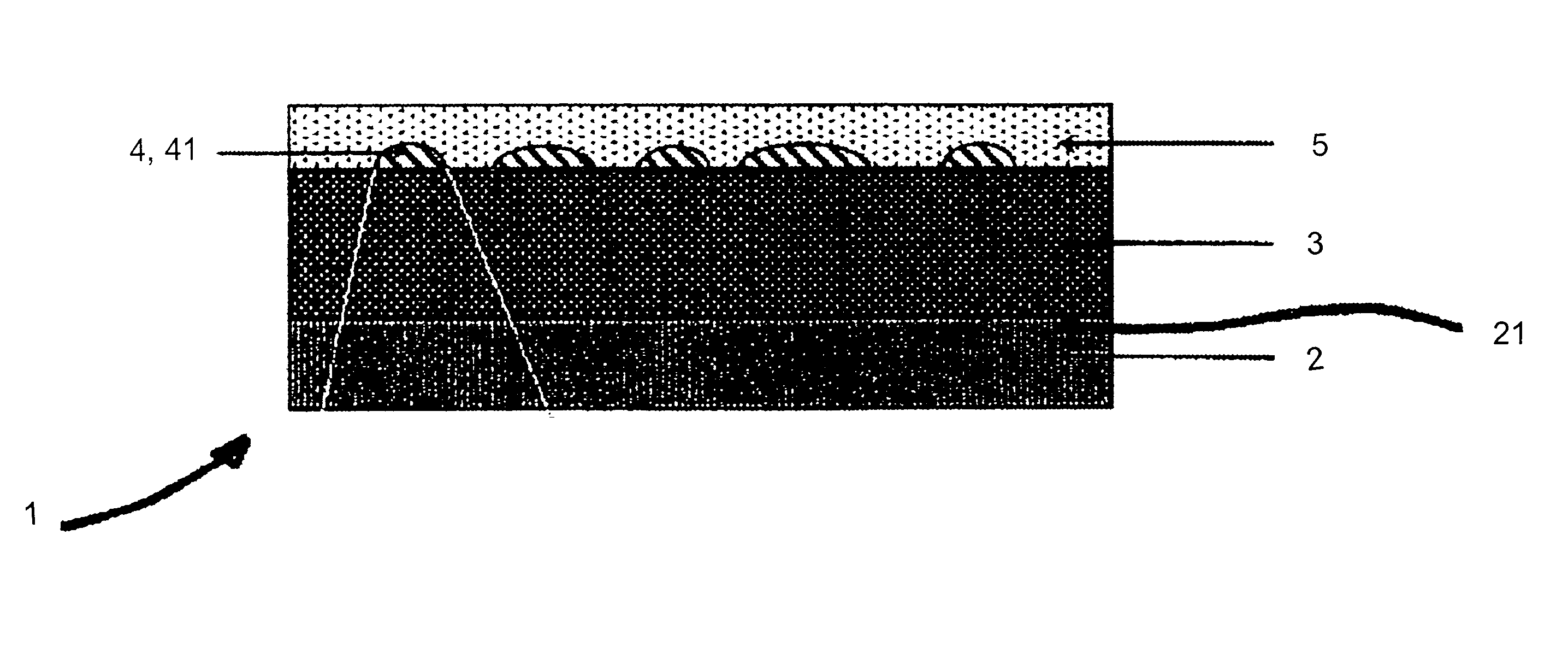Heating article including coloured heat indicator with improved visability and precision
a heat indicator and coloured technology, applied in the direction of heat measurement, curling-tongs, instruments, etc., can solve the problems of presenting a burn risk to people, presenting problems of electrical insulation, and indicators that are still complicated
- Summary
- Abstract
- Description
- Claims
- Application Information
AI Technical Summary
Benefits of technology
Problems solved by technology
Method used
Image
Examples
example 1
Production of a Cooking Article According to the Invention
[0146]A cooking container according to the invention is produced as described below, in reference to the appended figures provided as non-limiting examples:
[0147]The cooking container shown in FIG. 1 consists of a frying pan (or skillet) 1 comprising a substrate 2 with an internal surface 21 intended to be heated and to receive foods for cooking.
[0148]This internal surface 21 is covered by a continuous base coating layer 3.
[0149]A non-continuous design 4 including a plurality of patterns 41, 42 is applied to at least a portion of the base coating 3, which includes, as a thermostable binder resistant to at least 200° C., a sol-gel material obtained according to the embodiment described in example 5.
[0150]The composition of the design includes the pigment paste of example 4, based on thermochromic composite pigments 43 and thermostable pigments 44.
[0151]The composite pigments 43 are pigment grains with a core-envelope structure...
example 2
Production of the Thermochromic Pigment Bi2O3 in a Silica Envelope
[0155]After activation of the surface of the thermochromic SC pigment (Bi2O3) and milling to obtain a satisfactory particle size, a silica shell is formed by sol-gel from alkoxysilane precursors under basic conditions. This shell is then densified by a heat treatment so as to make it totally impermeable to grease. The procedure for synthesis of the shell is described below:
Activation
[0156]First, the thermochromic pigment in powder form is activated by heating of the powder at 430° C.
Milling
[0157]The composite particle sizes must be fine enough to be easily dispersed in a formulation and enable good colorimetric coverage of the coating obtained.
[0158]However, given that, after the encapsulation, the coated Bi2O3 powder can no longer be milled so as not to risk breaking the protection envelope just formed, it is necessary to obtain, before the synthesis of the envelope, an adapted particle size of the Bi2O3 powder. For ...
example 3
Production of a Base Layer 3 on the Internal Cooking Surface 21 of the Cooking Article According to the Invention of Example 1
[0167]A sol-gel composition is prepared in the form of a bi-component including a part A and a part B:[0168]part A includes a dispersion of colloidal silica, water to enable hydrolysis of the metal precursors of part B, isopropanol to enable good accounting for parts A and B and black food-grade pigments,[0169]part B comprises, as the sol-gel precursor, methyltriethoxysilane, which enables the formation of the matrix of the coating while rejecting only the ethanol (which is a non-toxic volatile organic compound (VOC), unlike methyltrimethoxysilane, which leads to the formation of methanol, a toxic VOC), as well as acetic acid, enabling the sol-gel reaction to be catalyzed.
[0170]These two parts A and B can be preserved for more than 6 months in this separated form.
[0171]Before the application on the internal surface of the cooking article as shown in FIG. 1, p...
PUM
| Property | Measurement | Unit |
|---|---|---|
| temperature | aaaaa | aaaaa |
| temperature | aaaaa | aaaaa |
| diameter | aaaaa | aaaaa |
Abstract
Description
Claims
Application Information
 Login to View More
Login to View More - R&D
- Intellectual Property
- Life Sciences
- Materials
- Tech Scout
- Unparalleled Data Quality
- Higher Quality Content
- 60% Fewer Hallucinations
Browse by: Latest US Patents, China's latest patents, Technical Efficacy Thesaurus, Application Domain, Technology Topic, Popular Technical Reports.
© 2025 PatSnap. All rights reserved.Legal|Privacy policy|Modern Slavery Act Transparency Statement|Sitemap|About US| Contact US: help@patsnap.com


